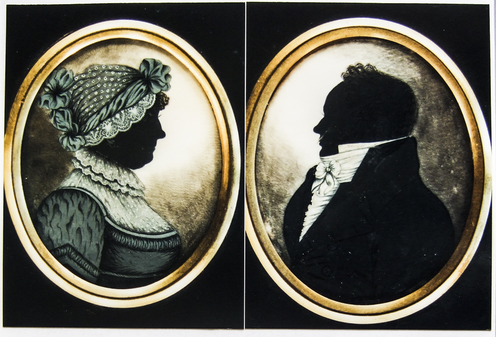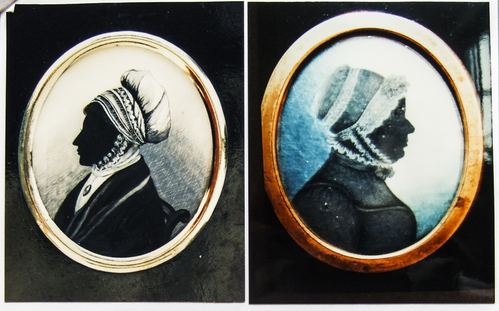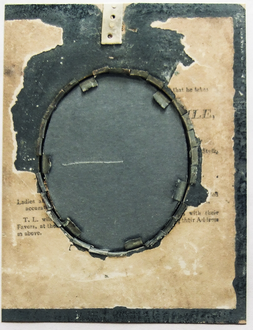London, Thomas (SCC Newsletter November 1999)
T.LONDON c.1798-1810 some examples of his work.

T London is a relatively rare silhouette artist. Nothing is known about his life or from what part of the country he originated. His works do not appear very often in the salerooms - although interestingly two silhouettes by him have been sold at Bonhams, Knightsbridge this year. One of these I will be illustrating later in this article and the other I mentioned under sale results in my last Newsletter. The latter was of a young girl (lot 14 sold on 11th. Feb.) She had no label but was bought by a member of the Silhouette Collectors' Club. After the new owner had removed the silhouette from it's frame he found London's signature on the obverse. This was exciting news as it is the first recorded signature of T. London.
His only known works are all painted on ivory - but strangely enough inspite of his obvious expertise on this medium he did not paint jewellery pieces as far as we know. Mrs. McKechnie in her Book has the main entry on his work on page 689. She also has a short entry under artists that worked on paper (i.e. Section 2 page 426). He states on his labels that he does work on paper although none has been recorded. Mrs. McKechnie took the view that if such work exsisted it would be similar to his work on ivory but unlikely to have the stippling on the background.
Above are illustrated a pair of silhouettes by Mr.London -I think these show his style and skills well. The base colour (i.e. the colour of the faces) of both these works is black - although Mrs. McKechnie refers to his base colour
T. LONDON cont’d.

being a dark grey. This was based on the examples she had seen - so clearly he used both colours. The woman's costume is painted in shades of grey water colour with some detail in chinese white. The painting on her cap and dress is very well executed and the whole silhouette gives a 'feel' of the sitter. Gum arabic has been used on the bodice of her dress and the decoration on her sleeve. There is a cluster of dark strokes to show the demarcation between her sleeve and her body. The man's stock and shirt are very carefully painted - using the ivory as the background colour for these. There is a thick line of creamy paint on the edge of the shirt frill. Gum arabic is used all over his hair and for details of his jacket - the latter can be seen on the photograph. Both silhouettes have background grey stippling - this is almost a hallmark of Mr. London's work. However, Mrs. McKechnie points out that some of his later works had plain backgrounds. Note that on the examples with stippling that he always left the space clear behind the sitter's face.
On this page are two further works by Mr. London. The first is the bonnetted lady sitting in her chair. She is the second silhouette sold by Bonhams this year (Lot 16 on 30th. June). She has photographed very well and seems to have been rather stylish in her mode of dress. She shows Mr. London's painting skills especially on her bonnet. She would appear to be wearing a silhouette locket around her neck! Gum arabic has been used for details of her black garment. The background stippling is more restrained than in the previous two examples. The second lady is an unattributed work sold in the United States a few years ago. I apologise for the quality of the photograph, but it is a rephotograph of one kindly sent to me by Helen and Nel Laughon. They keep me up-to-date on sales in the U.S.A. that include silhouettes by British artists. Inspite of the photograph's deficiencies I think it still gives a good 'feel' of the work. You will see that the sitter is somewhat similar to the lady on the previous page. The colour of the stippling has been altered by the photography.
T. LONDON cont’d

Silhouettes by Mr. London are smaller than most housed in standard papier mache frames of the period. These seem to vary from 2½" x 2¼" (or even slightly smaller) to 3" x 2½".The size of the frames for the couple at the beginning of this article are 2¾" x 2¼". Mrs. McKechnie illustrates 4 works on page 699 - the sizes of frames for these vary slightly. No work by Mr. London has a bust-line termination - all works go down to the base of the frame. I think you should be wary of a work on ivory attributed to London if it has a bust-line termination. The artist is understood to have used a machine to obtain his outline and the sitting-time was advertised at 5 minutes! Obviously he spent some considerable time after the sitting completing the clothing detail.
We know of two printed labels used by Mr. London. Both of these are illustrated in Mrs. McKechnie on page 699 - also the full text of both is given on page 689. Above is a remnant of Label No. 2. from the back of the frame housing the only gentleman illustrated in this article. Although little of the wording of the label is left there is still enough there to confirm the attribution of the silhouette to London. The initials T. L. near the bottom on the left-hand side are sufficient! So always look carefully at any printed lettering on the back of a frame - in case it can be matched with any recorded label. It is always possible that a replacement silhouette has been put in the frame - in that case the style and painting of the work has to be looked at with even greater care and reference made to known works by the artist.
In my view the works by T. London have a distinctive style which would be difficult to confuse with other artists of the period working on ivory. His works on paper (or porcelain - see Mrs. N. Jackson's Dictionary.) we have not seen so cannot compare. I hope this article has made it easier for those of you, who are not familiar with this artist to recognise him in the future.



